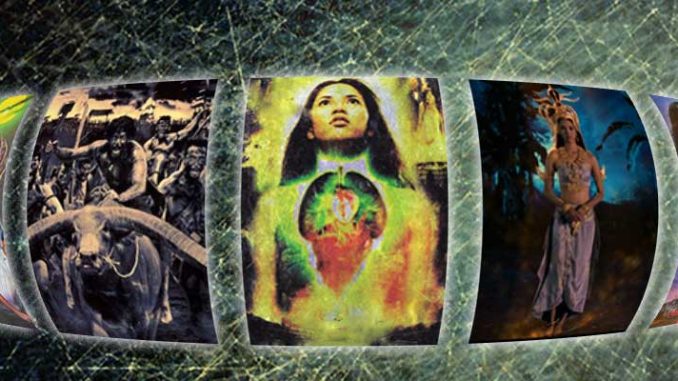
The Cultural Concept Phi
Western analysis attempting to approach the Thai cultural concept Phi usually starts with a translation that classifies the concept categorically as ghost and/or spirit. But since Thai has a deeply contextual and relational character, this classification merely represents a rapprochement to a cultural concept that is used to explicate the uncanny and its various manifestations in nearly all Tai cultures. Phi Krasue is not only one of the most well known uncanny beings of Thai folklore, it is also well suited to show the inappropriateness of Western categories in anthropological attempts to understand the uncanny in cross-cultural comparison. Since Western classificatory cultures would associate many of its most characteristic features with the concept “witch”, Phi Krasue and some analogous beings found in neighboring socio-cultures within the Thai geo-body and beyond, thus constitute a distinguishable Southeast Asian manifestation of the uncanny, that should be approached on the basis of indigenous cultural concepts before we attempt to translate it.
Like most uncanny beings marked with the broad pre-fix Phi, Phi Krasue had no origin myth that reached beyond local discourse prior to the release of Tamnan Krasue in the year 2002. Bin Banluerit’s film identifies the 13th century and Angkorian Khom/Khmer 1 culture as Phi Krasue’s origin. The questions being asked here are therefore: Why did this idiosyncratic Khmer origin myth appear shortly after the Asian Financial Crisis of 1997 and why hasn’t it been reviewed critically, although it breaks with the conventions of Thai oral traditions?
Phi Krasue’s Modern National Ghostly Image
Despite the still existing variety of regional names, a relatively homogenous national image of Phi Krasue seems to have emerged during the 20th century. Emanating from Bangkok, this image has spread throughout the Thai geo-body to penetrate even the remotest corners of the nation classifying this uncanny being as distinctively Thai. Ghost films, one of Thailand’s most popular movie genres, has thereby largely replaced oral traditions as the medium of reproduction and transmission of ghostly images. Although Phi Krasue is not the most prominent uncanny being in this genre, the few movies which portray this Phi seem to have been a powerful force in shaping this relatively homogenous national imagination. The national ghostly discourse thus identifies the host of Phi Krasue always as a woman who leads a normal life during the day. At night driven by an insatiable hunger, she is transformed whereby her head detaches itself from the body to hover through the air with nothing but some internal organs dangling beneath. In her search for impure food, Phi Krasue emits a pulsating glow, which may be seen moving through the night. The movies, just like the Thai oral traditions, are quite explicit about the impure character of Phi Krasue’s favorite foodstuff, but in contrast to its local counterparts, the national ghostly image seems to downplay Phi Krasue’s characteristic association with human feces, which was so prominent in local discourse that it prompted the anthropologist Robert Textor to translate Phi Krasue (1973) as the “filth ghost”.
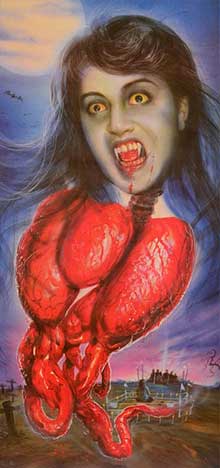
In the typical film plot, it is this craving for impure bodily substances that usually results in a fatal encounter between Phi Krasue and a fellow human being. As a consequence the host needs to be identified and although everyone knows that this uncanny being is hard to battle, an exorcism is inevitable. It is important to note that the hosts are mostly portrayed as passive victims, who are for a long time unaware of their nightly activities, and who, although they may have brought about their transformation into Phi Krasue actively, seldom act out of pure malevolence. Generally, the hosts were themselves victims of symbolic violence who, because of their subaltern social position, have no alternative way to seek justice but to resort to magic. Their transformation into Phi Krasue is thus not the intended goal of their magical practices, but results from the breach of certain taboos that accompany these practices and are largely irreconcilable with the daily routines of rural Thai women. Aspects of Thai social structures are thus mirrored in the popular religious idiom. Matrilineal filliation, which is another possible way of transmitting the uncanny being from one host to the next, is more prominent in the older movies featuring Phi Krasue and in oral traditions.
Bin Banluerit’s film “Tamnan Krasue”, literally “The Legend of Phi Krasue” but released with the more promising English subtitle “Demonic Beauty”, breaks with the hitherto imagined national ghostly image in various ways. Since Thai ghost movies that portray a too progressive image of their uncanny protagonists are usually received rather critically by Thai audiences (Ancuta 2011), it is somewhat surprising that these ruptures have yet to be discussed. Although it may be argued that the film’s success with the public was just too insignificant to justify a detailed analysis, I think that the movie offers a perfect foil to analyze the logic of socio-cultural classification processes in post-crisis Thailand. It is an analysis of this logic that may be able to explain why the ruptures between Phi Krasue’s modern and its post-modern national ghostly images haven’t been discussed. Such analysis may even contribute to our understanding of the current state of Thai-Cambodian relations.
The Asian Financial Crisis and the End of Thailand’s “Project Modernity”
Generally speaking “Thai modernity” must be seen as an elitists’ project with little meaning for local value configurations, leaving their internal logic relatively unchanged beyond introducing certain tropes. Marked by economic growth and relative wealth, the period from 1984-1997 is commonly known as the “boom years”, which saw a significant resurgence and (re-)invention of popular religious practices, figures and discourses. The Asian Financial Crisis of 1997 ended this liminal period and marks Thailand’s completed transition from “modernity” to “post-modernity”. In its aftermath the crisis was usually portrayed as an externally rooted threat to Thai national identity and sovereignty. It is thus no coincidence that state sponsored localism movements with the aim of reproducing and transmitting local knowledge and culture where blossoming in a time haunted by the image of an externally caused crisis of “Thainess”. An important part of these state sponsored movements was the reproduction of an idealized and romanticized image of the autark Siamese village as a kind of “paradise lost”.
Post-Crisis Thailand, the Period of “Period Films”
This longing for a lost ideal ushered by localism explains why period films constituted the most successful movie genre in post-crisis Thailand. The biggest blockbusters during this period Nang Nak (1999), Bang Rajan (2000) and Suriyothai (2001), these not only conjure memories of Thailand’s golden past while invoking the image of the Siamese struggle to ward of external enemies, but simultaneously reproduce the romantic ideal of Siamese village life. The idiosyncratic nature of Phi Krasue’s origin myth in Tamnan Krasue has to be analyzed with reference to these blockbusters to which Banluerit’s film is intertextually linked. Released shortly after Suriyothai, Tamnan Krasue reproduces their main plot structures: set in the year 1220 it starts with a Siamese victory, while re-imagining the first epigraphically backed revolt of Siamese nobles against their Khmer overlords (Wyatt 2001), and just like Mae Nak in Nang Nak, its protagonist is an uncanny female being well known from Thai folklore. Nevertheless, the essential divergence from these intertextually related blockbusters is essential to understand the socio-cultural logic structuring post-crisis Thailand and therefore Phi Krasue’s origin myth in Tamnan Krasue.
The Invented Khmer origin of a “Thai-Ghost”
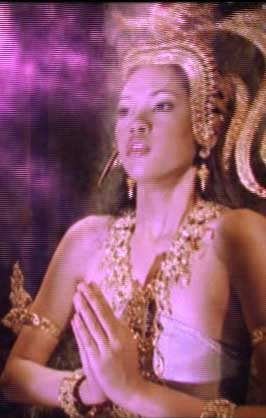
In contrast to the three blockbusters, where the threat to Thainess originates in the physical force of the Burmese army, Tamnan Krasue depicts this threat as being rooted in Angkorian Khmer culture and as spiritual in nature. Its threatening potential if further raised by its emanation from magical practices and its manifestation as an uncanny being. In contrast to local oral traditions the movie depicts Phi Krasue as the intended and direct outcome of magical rituals performed by a Khmer “witch”. In the course of the film the uncanny being takes revenge for the cruelties of a Siamese nobleman who first captures a Khmer princess (depicted throughout the film as an Apsara) and finally sentences her to death on a pyre. Phi Krasue victims are the residents of a peaceful Siamese village, whereby she uses the body of a village girl as host. This village girl resembles the executed Khmer princess twin-like in every aspect. Although the Khmer witch’s “black” magic is defeated in a final battle by the village monk’s “white” magic, the film ends with the uncanny being taking possession of the next village girl. The film’s final message is that ever since that time, the uncanny being Phi Krasue would be known in Thailand.
Conclusion
The reasons for the invention and acceptance of this idiosyncratic origin myth and the cultural stereotypes it reproduces have to be sought in the implicit logic structuring the socio-cultural classification processes in post-modern Thailand. Khmer, as a socio-cultural category, occupies a central position in these processes and is characterized by a high degree of intrinsic ambiguity. As a source of origin, Angkorian Khmer culture is of immense importance for Thai cultural heritage. Nevertheless, this noteworthiness is rarely acknowledged in official Thai discourse despite seeming obvious, and that makes the intrinsic Khmer aspects of everyday Thai culture easily discernible but hard to explicate for the cultural practitioner. The sociocultures, Thai and Khmer, are indeed so similar that it takes huge amounts of symbolic work to keep them distinct. During Thailand’s modernity this symbolic task was facilitated by the Cold War and both sociocultures’ opposed positioning within this global frame of reference. The drawing of the symbolic boundary became ever more difficult and ambiguous with the Cold War’s end which fell into the liminality of the “boom years”. The “boom years” thus saw a shift of reference, where the socio-cultural category Khmer became more explicitly associated with occult forms of knowledge. This association was enhanced by the logics of localism with its emphasis of local wisdom but also by the booming of popular prosperity cults which made the Khmer-magic-link a logical reasoning in contemporary Thai society. The Khmer-magic-link is so well accepted that “magic” is not only the first category mentioned by Bangkok based interlocutors when ask what they associate with the category “Khmer” but also by members of the Khmer-speaking population of Thailand’s lower Northeast, where I did my fieldwork.
[quote]“The film re-imagines the Thai nation’s moment of birth, while simultaneously emphasizing that the essential symbolic boundary separating “Khmer” and “Thai” had to be drawn violently”.[/quote]
The idiosyncrasy of the Khmer origin myth in Tamnan Krasue thus lies in the eye of the beholder. From an analytic viewpoint, one may point to the ruptures and breaks separating Phi Krasue’s more traditional ghostlore from its post-modern counterparts while remarking that any reference to Khmer culture is absent in these older sources. For a Thai, socialized since the “boom years” the Khmer origin of Phi Krasue appears as totally logical. Since Phi Krasue’s genesis is located in malevolent magical practices and the most potent of these practices are usually associated with the socio-cultural category Khmer, it is just logical to locate Phi Krasue’s origin in Angkorian Khmer culture. Therefore, the film should not be seen as an example of active ethnic stereotyping but as an ideological project aiming at re-drawing the symbolic boundary separating the socio-cultures “Khmer” and “Thai” in a time of crisis. The film re-imagines the Thai nation’s moment of birth, while simultaneously emphasizing that the essential symbolic boundary separating “Khmer” and “Thai” had to be drawn violently. Finally, it acknowledges that aspects of Khmer culture will forever remain within the Thai geo-body. The village girl, who resembles the Khmer princess like a twin, thus becomes a metaphor for “Thainess” and its geo-body, whose identity and integrity is continuously haunted from within by “Khmerness” in form of its uncanny manifestation as Phi Krasue.
Benjamin Baumann
Benjamin Baumann studied Anthropology and Southeast Asian Studies. He is a lecturer at Humboldt-Universität zu Berlin’s Institute for Asian and African Studies. Benjamin is currently working on his PhD thesis entitled “The Ritual Reproduction of ‘Khmerness’ in Thailand: Popular Religion and Social Structure at the Nation State’s Periphery”.
Kyoto Review of Southeast Asia, (Issue 14), Young Academics Voice, December 2013
References
Ancuta, Katarzyna. (2011) Global Spectrologies: Contemporary Thai Horror Films and the Globalization of the Supernatural. Horror Studies 2:131-44.
Textor, Robert. (1973) Roster of the Gods: An Ethnography of the Supernatural in a Thai Village. Human Relations Area Files.
Wyatt, David. (2001) Relics, Oaths and Politics in Thirteenth-Century Siam. Journal of Southeast Asian Studies 32:3-66.
Notes:
- For the sake of clarity and since the distinction Khom/Khmer is an idiosyncratic political construction; I will use the socio-cultural category Khmer throughout the rest of this article although the film talks about Khom. ↩

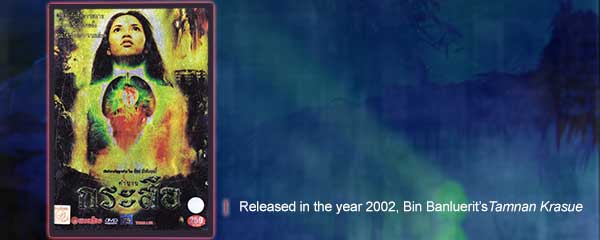
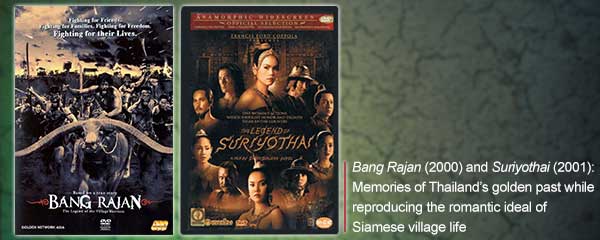
This is a fascinating article. Thanks very much!
This is so interesting! I don’t think I’ve not read a thing like this before. So good to see original thoughts on this issue. Thanks for this.
Called “ahp” in Khmer
Dear Tom,
thanks for your comment. Could you please clarify what is called “ahp” in Khmer.
See: http://en.wikipedia.org/wiki/Krasue … every Cambodian knows Ahp. It’s in many movies too.
Thanks